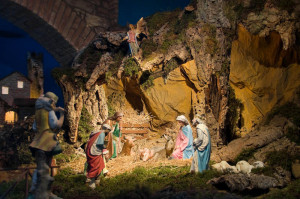 Nearly every Southern Italian town has a presepio, often of life-sized crèche figures or even a living tableau that retells the story of that heralded night in Bethlehem. Some of the best are in Greccio, Rome, and Naples. Visiting these nativity scenes is one of the highlights of visiting Naples with kids during the holiday season.
Nearly every Southern Italian town has a presepio, often of life-sized crèche figures or even a living tableau that retells the story of that heralded night in Bethlehem. Some of the best are in Greccio, Rome, and Naples. Visiting these nativity scenes is one of the highlights of visiting Naples with kids during the holiday season.
The history of Southern Italy’s Christmas Nativity Scenes can be traced back to St. Francis of Assisi, who is credited with creating the first public nativity scene, or presepio, as the Italians call them, in 1223, when he built a replica of the manger scene at his hermitage in Greccio, on a mountain near Assisi. People from the village climbed in a torch-lit procession to see the nativity, which included a donkey with an ox next to it to make it more real.
The scene is repeated every Christmas Eve at the hermitage at Greccio, which looks much the same as it did in St. Francis’s time, and all over Italy. Some of these are living nativity scenes with real people, while others use life-sized or smaller figures made of carved wood, terracotta and other materials. Often the figures are dressed in real clothing.
Most of Rome’s churches have presepi, some of which show priceless old figures that have been treasured for centuries. Large outdoor scenes are set up on the Spanish Steps, in Piazza del Popolo, in St. Peter’s Square at the Vatican, and at the Christmas market in Piazza Navona, along with several other places. The crèche at the Spanish Steps includes an 18th-century street scene.
Naples is known for having Italy’s most elaborate presepi, and is also famous for the craftsmen who create the Nativity figures. May of these are carved from wood and dressed in satin finery. In the month of December, Via San Gregorio Armenov in Naples is lined with craftsmen selling Nativity figures and scenes of wood, ceramic, terracotta, plaster, and other materials. Also in Naples, Galleria Umberto has a huge presepio based on Neapolitan scenes. An immense collection of crèche scenes and figures dating as far back as the 1400’s is on display at the Museo della Certosa di San Martino, high on a hill overlooking Naples.
In some towns these static scenes take on even more meaning as live tableaux or pageants – presepi viventi, where local people perform the roles. They are usually staged on December 23-26, and often again on January 6. Each town reenacts its own version.
In Abruzzo, Rivisondoli’s living Nativity scene includes hundreds of costumed people dramatizing the arrival of the Three Kings on Epiphany. In the Tuscan town of Barga, on the evening of December 23, more than 100 costumed people form a procession behind Mary and Joseph, walking through the town asking costumed tradesmen for lodging. The procession ends at the main square, where a star guides the arrival of the Wise Men.
At Custonaci, in Sicily, the scene is set in a cave. A tiny town is reconstructed (an actual town was here once, but buried by a landslide) as the setting for the live tableau.
Although Southern Italy’s Christmas Nativity Scenes are local religious observances and not performances for the amusement of tourists, visitors are warmly welcomed at all of them. The best places to shop for entire scenes or for individual crèche figures is at the market on Via San Gregorio Armeno in Naples.
By Barbara Radcliffe Rogers
Read Next: Rome Family Holiday Ideas during Christmas and New Years
 Add to favorites
Add to favorites
Connect